ABSTRACT
The Korean agricultural situation is expected to change more rapidly in future. In particular, the globalization and expansion of food markets in the world following the expansion of market liberalization would also require a new agricultural paradigm. It is important to seek a new strategies for agricultural and rural development in order to continue the agricultural reform, including digital transformation to apply AI(artificial Intelligence), bigdata, cloud system, etc in agriculture. For precision agriculture, Korea understands the change in the agricultural paradigm rather than the choice of farming methods and recognizes it in the inevitable development process of agriculture in the knowledge and information-based industrial society.
There had been some precision farming-related research and development under the concept of "Low Input Sustainable Agriculture" in Korea. Activities have been mainly focused on rice production, since rice is a major crop to feed the population. Site variables in interest are soil properties, crop growth status, and crop yield. Since rice paddy fields are flooded and flat, agricultural scientists had hypothesized that spatial variability in yields and soils might be negligible. However, significant levels of variability in rice yields and many soil nutrients, even in small Korean paddy fields, have been observed. Rice yield variations between high-yielding and low-yielding areas were about 30% even in small (i.e., 0.4 ha, or 1 acre) paddy fields. Spatial patterns of several soil properties (e.g., EC and P2O5) also showed within-field variability and were somewhat related to irrigation water flow.
Measurement and management of the small-scale variability in Korean fields raises both challenges and opportunities for precision agriculture. Small-scale variability requires more careful consideration on determination of design parameters and data processing issues. Diverse strategies are under investigation, depending on controllability of the variability, type of operation, and economic feasibility: sensor-based vs. map-based practices and within-field vs. inter-field management. Experience and accomplishments in Korean precision agriculture might be also used for other Asian countries where agricultural environments and cropping systems are similar. There is a great potential to apply site-specific technologies and management strategies developed for rice production to other areas such as orchards and protected horticulture that would lead to good economic returns.
Keywords: Korea Agriculture, Rice farming, Paddy Field, Precision Farming
STATUS OF KOREAN AGRICULTURE
Overview of Korea’s farmlands
As of the end of 2018, Korea has 10,027 thousand ha of land area. Farmland makes up 16% of land in korea, or 1,596 thousand ha, with 844 thousand ha of rice paddies and 751 thousand ha of fields. The total farmland area has been on a downward trend since the 1970s (Table.1). Korea’s cultivated land per capita is 0.04ha, which is very small compared to major advanced countries (U.S. 1.5ha, France 0.5ha, UK 0.3ha). Therefore, its food self-sufficiency rate is very low. Although the self-sufficiency rate of rice, the staple crop, is almost 100% because of government investment in the production base and decline in rice consumption, the self-sufficiency rate of grains as a whole is merely 23%. Despite the low self-sufficiency rate of food, a considerable share of farmland under worsening farming conditions has become idle land or forest due to continued expansion of agricultural imports, and such a trend is projected to continue. In recent years, about 40,000ha of farmland have become idle every year, and much of the deserted land has turned into a land that is difficult to use again. Apart from the idling of farmland, about 15,000ha of farmland are converted to other uses every year. As a result, farmland continues to decrease despite various efforts to create and
preserve farmlands.
Table. 1. The changes of Korea Farmland
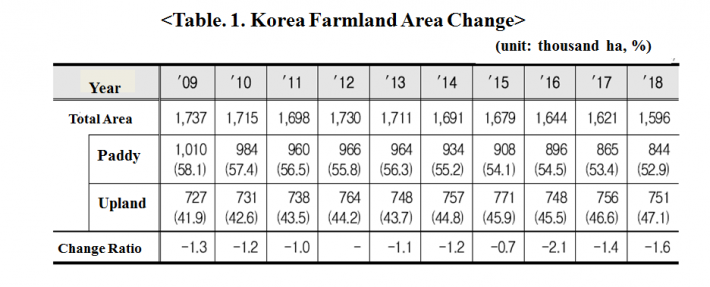
Use and conversion of farmlands
Amid an overall decline in the farmland area, the number of farms fell sharply, while arable land was lost relatively slowly. As a result, the cultivated land area per farm household saw a gradual rise from 0.93 ha in 1970 to 1.19 ha in 1990, 1.37 ha in 2000, 1.46 ha in 2010 and to 1.56 ha in 2017. Still, Korea’s cultivation area per farm is very small compared to the US, France, the UK and Germany, requiring an aggressive expansion of farming scale.
Furthermore, worsening conditions for agriculture have steadily increased the amount of idle farmland, reducing total farmland area from 2.298 million ha in 1970 to 1.715 million ha in 2010 and to 1.596 million ha in 2018. The abandoned farmland area, three to four times the converted land area, is increasing driven mainly by poor production infrastructure and labor shortages. Greater opening of the agricultural market in recent years is also creating difficult farming conditions, resulting in a steady rise in the area of idle farmland.
Farm scale expansion
While cultivated land area per farm is increasing slowly, the concentration of farmland in bigger farms is rising at a fairly rapid pace. During 1995-2014, the share of farms with over 3.0 ha of farmlands jumped from 4.7% to 8.7%.
Farmland mobilization, which encourages business expansion to improve the agricultural structure, is carried out through the Farm Scale Expansion Project and the farmland bank project in an effort to expand farming scale, promote farmland collectivization, cut production costs and increase competitiveness through trade, long-term lease and exchange, subdivision or combination of farmlands. The Farm Scale Expansion Project succeeded in expanding and collectivizing 167 thousand ha of farmlands with 6.8 trillion won of loans, bringing up the average scale of rice farms from 2.5 ha in 1995 to 5.9 ha in 2013.
The farmland bank project aims for efficient use of farmland by promoting leases and purchase of farmland, stable incomes for farmers and farmland market stability. Projects related to farmland mobilization include the farmland lease project and the project to purchase and stockpile farmlands. The farmland lease project was designed to hold leasable farmland in trust and lease the land out to full-time farmers on a long-term basis.
The ratio of leased farmlands rose from 17.8% in 1970 to 37.4% in 1990, 47.9% in 2010 and to 50.0% in 2013, even though the Farmland Act prohibits farmland leasing. The reason for the rise in farmland lease is that, on one hand, farmland ownership by non-farmers has increased due to farmers leaving the profession and non-farmers inheriting the land and, on the other hand, most farms are expanding their business scale rather by leasing farmlands than by buying farmland on economic grounds.
Current status of agricultural human resources and aging farmers
The agricultural population has been decreased continuously to 2,315 thousand households in 2018 by 2.0% on yearly average from 14,422 thousand households in 1970. However, the problem lies not in the decline itself, but in the aging of agricultural population. In 1970, people in their 20s and 30s accounted for 35.2% of the total farm owners and people over 60 took up 15.2% only. The shares of these two became 0.7% and 76% in 2018, and the youth population drastically fell and the aged population increased. Agricultural population aging is particularly serious compared to other major countries.
RICE PRECISION FARMING IN KOREA
Precision farming in Korea
For precision agriculture, Korea understands the change in the agricultural paradigm rather than the choice of farming methods and recognizes it in the inevitable development process of agriculture in the knowledge and information-based industrial society. Precision agriculture produces synergetic effects when used in combination with various environmentally friendly agricultural technologies (organic agriculture, natural agriculture, etc.) and agricultural technologies (IPM, INM) for applying chemistry. Precision farming can be applied in various ways depending on the agricultural working conditions, the region and the climatic environment, and it is expected to develop in various ways according to the development of industrial technology and the change of agricultural production system.
Precision agriculture in Korea is aiming for scientific agriculture, safe agriculture and sustainable agriculture, and it is regarded as a core value of rich rural and clean natural environment, high quality of farmer's life, which harmonizes people, agriculture and environment. We combine farming and ICT to automate and make it smarter, create easier and more comfortable farming and higher income, and stably supply safe food to the people. Through the scientificization of agriculture, farmers realize the high quality of agricultural culture and quality of life by practicing the principle of coexistence in consideration of nature and human beings. For this reason, at first we try to maintain clean and comfortable nature and rural environment to reduce soil pollution and emission of pollutants to the air and water system (nitrate and nitrite, etc). to reduce unnecessary input of agricultural materials.
Rice precision farming in Korea
There had been some precision-related research and development under the concept of "Low Input Sustainable Agriculture" in Korea, but it was not until late '90s when the concept of precision agriculture was introduced to the public through international seminars and symposiums, and research projects were initiated by scientists in government agencies and universities. Activities have been mainly focused on rice production, since rice is a major crop to feed the population (Figure.1). Site variables in interest are soil properties, crop growth status, and crop yield. Since rice paddy fields are flooded and flat, agricultural scientists had hypothesized that spatial variability in yields and soils might be negligible. However, significant levels of variability in rice yields and many soil nutrients, even in small Korean paddy fields, have been observed. Rice yield variations between high-yielding and low-yielding areas were about 30% even in small (i.e., 0.4 ha, or 1 acre) paddy fields. Spatial patterns of several soil properties (e.g., EC and P2O5) also showed within-field variability and were somewhat related to irrigation water flow. Equipment such as electrical conductivity and yield monitoring sensors and software packages have been introduced from the U.S. and Canada, not only to learn about the technologies, but also to investigate the feasibility in unique Korean agricultural situations (Figure.2). Some of the introduced technology showed issues to be resolved to meet the Korean cropping systems. For example, grain flow sensors that were designed for wheat and corn production in large U.S. fields were unable to measure the small amount of flow in a Korean rice combine typically harvesting 4 to 6 rows. In addition to hardware issues, data filtering issues such as flow delay and inconsistent harvesting width are much more challenging (Figure.3). Crop growth sensors need to be calibrated for rice through intensive sampling and analysis, and variable rate nutrient application systems need to be reduced in size. Lessons from the experience are that site-specific variability exists among different countries and cropping systems, and that equipment and strategies should be developed and established to meet and manage the site-specific variability unique to Korea.
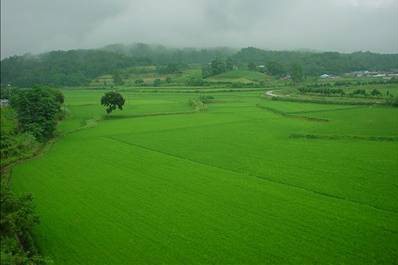
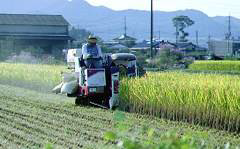
Figure 1. Paddy fields (left) and combine harvester (right) for the Korean rice production
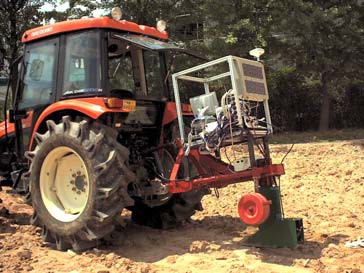
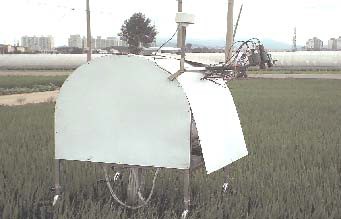
Figure 2. A soil organic matter content sensor (left), and a rice growth status sensor (right)
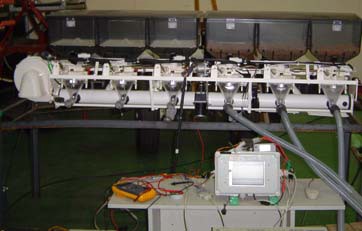
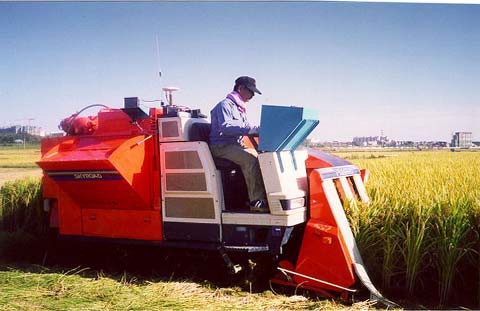
Figure 3. A variable rate granular fertilizer controller (left), and a rice yield monitoring system (right)
Korean-version equipment is under development as well as adoption of technologies from foreign countries. Some of them include field data collection platforms with the capability of logging GPS positional information along with sensor readings, soil sampling devices, sensors for soil properties such as organic matter content, soil strength, water content, and electrical conductivity, and sensors for crop growth monitoring such as plant height, leaf coverage, and chlorophyll content. Rice yield monitoring systems and variable rate controllers for liquid and granular agrochemicals have been also studied
A case study of farming systems research in Korea rice paddy field
To obtain basic information for precision agriculture, the spatial variability of growth and yield for rice plants was investigated over a 0.4 ha paddy field in the Kimje plain area of Korea. The experimental field was divided into side-by-side control and variable rate treatment (VRT) areas, and soil samples, measured soil hardness, and ground conductivity by EM38 readings were taken yearly. Soil samples were analyzed for pH, EC, NH4-N, NO3-N, T-N, P2O5, K, SiO2. Fertilizer recommendation maps were created based on results. The pH and organic matter were at optimum levels for rice cultivation, and available phosphate was higher than optimum. EM38 measurements and soil EC were correlated, and the soil hardness was different before seeding vs. after harvest. Soil chemical properties showed a big variation within the field, as well as fertilizer recommendations. These results indicate that variable rate fertilization could offer a relative advantage in this field. Grid sampling was conducted with each of the 4.3m x 10.2m plots in a 35m x 112m paddy field. Eighty-eight surface soil samples were collected before soil puddling to investigate the spatial variability of their chemical properties. The growth characteristics data were collected at heading stage from each plot and the grain yield was measured in each 8.6m x10.2m plot at harvest.
Geostatistical analysis and mapping were performed by GS+ Geostatistics software. The yield variations in the grid ranged from 7.5ton/ha to 10.2ton/ha. The range of spatial dependence was about 40m for grain yield. Yield maps correlated with growth maps, showing continuity in spatial variation. The spatial distribution of N recommendations for variable rate application showed similarity with the yield map in spatial variation.
The experiment was conducted to verify the effect of variable rate nitrogen fertilization. A Micro-Track yield monitoring system was installed on Kukje 575-G combine. In outdoor calibration, the standard deviation of GPS was 1.2m. The coefficient of variation of the tractor speed sensor 5% while that of flow sensor was 2%, but error was increased at cereal tank fills more than 3/4, or at starting harvest. Errors of acquired yield data were decreased by data cleaning and averaging by plot. Finally, the yield map could be drawn using cleaned and averaged data. The control plot was applied with a conventional rate of N fertilizer, while the VRT plot was applied with variable rate based on N fertilizer recommendation from soil analysis (Figure 4).

Figure 4. Rice yields in control (top) and variable rate nitrogen (bottom) experiments
The average amount of N fertilizer in the VRT plot was 18kg/ha less than in the control. Most of growth values in the VRT plot were higher than in the control. Coefficients of variation in grain yield were 64.1% in the control plot, but 9.2% in the VRT plot, respectively. In the VRT plot, yield variation was minimized and average yield was 34% higher than the control. There was no difference on nitrate contents of infiltrated soil water in control and VRT plot, and quality of rice grain in the VRT plot was slightly better than the control. According to the results, variable rate fertilization of paddy rice was effective in reducing fertilizer without decreasing yields and variations in growth and yield. Economic performance of precision agriculture was analyzed by the partial budget method based on production cost in the experimental farm households. According to the results of the economic analysis on the experimental plots and farm households, even though the fertilizer amount per unit area was more than fertilizer applied with the soil survey, if farmers bear the total expenses for precision agriculture, they were faced with a large deficit for their farm management. However, if government supports some part of cost for soil survey or GPS for precision agriculture, they showed the possibility for adopting techniques of precision agriculture.
Precision agriculture results in reducing environmental pollution by using smaller amounts of chemical fertilizer and pesticides. It can justify government support for some part of its expenses.
CHALLENGES AND OPPORTUNITIES OF RICE PRECISION FARMING IN KOREA
When the Korean government pushed a production-oriented rice policy for food self-sufficiency in past years, rice farmers applied too much pesticide and chemical fertilizer for rice cultivation and resulted in serious pollution problems in rural areas. Recently, the international standard of organic farm products has been established and OECD is developing the index of agricultural environment. Therefore, the various regulations for agricultural environment should be strengthened in Korea. To meet such a changing situation Korean government established laws for encouraging environment-friendly farming, and carried out various plans to support them. However, the environment-friendly farming has its limitations in the purposes of both increasing productivity and expanding farm area. Adopting precision agriculture is an alternative approach to overcome these limitations. Precision agriculture has the potentiality to achieve the reduced use of pesticide and fertilizer through variable rate fertilizer application, site-specific herbicide application, and field guidance systems while simultaneously increasing productivity through the large-scale farming. Therefore, precision agriculture is an intuitively appealing technology for large farmers and policy makers as a tool of responding in an environmentally sound fashion. Measurement and management of the small-scale variability in Korean fields raises both challenges and opportunities for precision agriculture. Small-scale variability requires more careful consideration on determination of design parameters and data processing issues. Diverse strategies are under investigation, depending on controllability of the variability, type of operation, and economic feasibility: sensor-based vs. map-based practices and within-field vs. inter-field management. Experience and accomplishments in Korean precision agriculture might be also used for other Asian countries where agricultural environments and cropping systems are similar.
Korean precision agriculture seems to be entering a new phase. Although related technologies have been developing and economic benefits from site-specific field management have been reported, economic feasibility is still questionable. Establishment of pilot farms and long-term and inter-disciplinary investigation is critical. Rice production has been the main interest of past activities. There is a great potential to apply site-specific technologies and management strategies developed for rice production to other areas such as orchards and protected horticulture that would lead to good economic returns. Site-specific management presents opportunities to those who see things differently and try to manage them.
REFERENCES
Korean Statistical Information Service, 2018, Korean Agriculture survey
SCKim. 2018, Smart Farm and Agriculture Robot , 2018 Seminar on Status and Prospects of Korean Smartfarm, Korea RDA
SKChoi, etc., , 2015, OECD Report-Agriculture in Korea 2015-, Korea Rural Economic Institute
SCkim, etc.,2012. Precision Agriculture-Convergence of Agriculture and ICT, Korea RDA
Sun-Ok, etc., 2002, Precision Agriculture in the Republic of Korea, Purdue University
|
Date submitted: August 5~9, 2019
Reviewed, edited and uploaded: August 15, 2019
|


Rice Precision Farming in Korea
ABSTRACT
The Korean agricultural situation is expected to change more rapidly in future. In particular, the globalization and expansion of food markets in the world following the expansion of market liberalization would also require a new agricultural paradigm. It is important to seek a new strategies for agricultural and rural development in order to continue the agricultural reform, including digital transformation to apply AI(artificial Intelligence), bigdata, cloud system, etc in agriculture. For precision agriculture, Korea understands the change in the agricultural paradigm rather than the choice of farming methods and recognizes it in the inevitable development process of agriculture in the knowledge and information-based industrial society.
There had been some precision farming-related research and development under the concept of "Low Input Sustainable Agriculture" in Korea. Activities have been mainly focused on rice production, since rice is a major crop to feed the population. Site variables in interest are soil properties, crop growth status, and crop yield. Since rice paddy fields are flooded and flat, agricultural scientists had hypothesized that spatial variability in yields and soils might be negligible. However, significant levels of variability in rice yields and many soil nutrients, even in small Korean paddy fields, have been observed. Rice yield variations between high-yielding and low-yielding areas were about 30% even in small (i.e., 0.4 ha, or 1 acre) paddy fields. Spatial patterns of several soil properties (e.g., EC and P2O5) also showed within-field variability and were somewhat related to irrigation water flow.
Measurement and management of the small-scale variability in Korean fields raises both challenges and opportunities for precision agriculture. Small-scale variability requires more careful consideration on determination of design parameters and data processing issues. Diverse strategies are under investigation, depending on controllability of the variability, type of operation, and economic feasibility: sensor-based vs. map-based practices and within-field vs. inter-field management. Experience and accomplishments in Korean precision agriculture might be also used for other Asian countries where agricultural environments and cropping systems are similar. There is a great potential to apply site-specific technologies and management strategies developed for rice production to other areas such as orchards and protected horticulture that would lead to good economic returns.
Keywords: Korea Agriculture, Rice farming, Paddy Field, Precision Farming
STATUS OF KOREAN AGRICULTURE
Overview of Korea’s farmlands
As of the end of 2018, Korea has 10,027 thousand ha of land area. Farmland makes up 16% of land in korea, or 1,596 thousand ha, with 844 thousand ha of rice paddies and 751 thousand ha of fields. The total farmland area has been on a downward trend since the 1970s (Table.1). Korea’s cultivated land per capita is 0.04ha, which is very small compared to major advanced countries (U.S. 1.5ha, France 0.5ha, UK 0.3ha). Therefore, its food self-sufficiency rate is very low. Although the self-sufficiency rate of rice, the staple crop, is almost 100% because of government investment in the production base and decline in rice consumption, the self-sufficiency rate of grains as a whole is merely 23%. Despite the low self-sufficiency rate of food, a considerable share of farmland under worsening farming conditions has become idle land or forest due to continued expansion of agricultural imports, and such a trend is projected to continue. In recent years, about 40,000ha of farmland have become idle every year, and much of the deserted land has turned into a land that is difficult to use again. Apart from the idling of farmland, about 15,000ha of farmland are converted to other uses every year. As a result, farmland continues to decrease despite various efforts to create and
preserve farmlands.
Table. 1. The changes of Korea Farmland
Use and conversion of farmlands
Amid an overall decline in the farmland area, the number of farms fell sharply, while arable land was lost relatively slowly. As a result, the cultivated land area per farm household saw a gradual rise from 0.93 ha in 1970 to 1.19 ha in 1990, 1.37 ha in 2000, 1.46 ha in 2010 and to 1.56 ha in 2017. Still, Korea’s cultivation area per farm is very small compared to the US, France, the UK and Germany, requiring an aggressive expansion of farming scale.
Furthermore, worsening conditions for agriculture have steadily increased the amount of idle farmland, reducing total farmland area from 2.298 million ha in 1970 to 1.715 million ha in 2010 and to 1.596 million ha in 2018. The abandoned farmland area, three to four times the converted land area, is increasing driven mainly by poor production infrastructure and labor shortages. Greater opening of the agricultural market in recent years is also creating difficult farming conditions, resulting in a steady rise in the area of idle farmland.
Farm scale expansion
While cultivated land area per farm is increasing slowly, the concentration of farmland in bigger farms is rising at a fairly rapid pace. During 1995-2014, the share of farms with over 3.0 ha of farmlands jumped from 4.7% to 8.7%.
Farmland mobilization, which encourages business expansion to improve the agricultural structure, is carried out through the Farm Scale Expansion Project and the farmland bank project in an effort to expand farming scale, promote farmland collectivization, cut production costs and increase competitiveness through trade, long-term lease and exchange, subdivision or combination of farmlands. The Farm Scale Expansion Project succeeded in expanding and collectivizing 167 thousand ha of farmlands with 6.8 trillion won of loans, bringing up the average scale of rice farms from 2.5 ha in 1995 to 5.9 ha in 2013.
The farmland bank project aims for efficient use of farmland by promoting leases and purchase of farmland, stable incomes for farmers and farmland market stability. Projects related to farmland mobilization include the farmland lease project and the project to purchase and stockpile farmlands. The farmland lease project was designed to hold leasable farmland in trust and lease the land out to full-time farmers on a long-term basis.
The ratio of leased farmlands rose from 17.8% in 1970 to 37.4% in 1990, 47.9% in 2010 and to 50.0% in 2013, even though the Farmland Act prohibits farmland leasing. The reason for the rise in farmland lease is that, on one hand, farmland ownership by non-farmers has increased due to farmers leaving the profession and non-farmers inheriting the land and, on the other hand, most farms are expanding their business scale rather by leasing farmlands than by buying farmland on economic grounds.
Current status of agricultural human resources and aging farmers
The agricultural population has been decreased continuously to 2,315 thousand households in 2018 by 2.0% on yearly average from 14,422 thousand households in 1970. However, the problem lies not in the decline itself, but in the aging of agricultural population. In 1970, people in their 20s and 30s accounted for 35.2% of the total farm owners and people over 60 took up 15.2% only. The shares of these two became 0.7% and 76% in 2018, and the youth population drastically fell and the aged population increased. Agricultural population aging is particularly serious compared to other major countries.
RICE PRECISION FARMING IN KOREA
Precision farming in Korea
For precision agriculture, Korea understands the change in the agricultural paradigm rather than the choice of farming methods and recognizes it in the inevitable development process of agriculture in the knowledge and information-based industrial society. Precision agriculture produces synergetic effects when used in combination with various environmentally friendly agricultural technologies (organic agriculture, natural agriculture, etc.) and agricultural technologies (IPM, INM) for applying chemistry. Precision farming can be applied in various ways depending on the agricultural working conditions, the region and the climatic environment, and it is expected to develop in various ways according to the development of industrial technology and the change of agricultural production system.
Precision agriculture in Korea is aiming for scientific agriculture, safe agriculture and sustainable agriculture, and it is regarded as a core value of rich rural and clean natural environment, high quality of farmer's life, which harmonizes people, agriculture and environment. We combine farming and ICT to automate and make it smarter, create easier and more comfortable farming and higher income, and stably supply safe food to the people. Through the scientificization of agriculture, farmers realize the high quality of agricultural culture and quality of life by practicing the principle of coexistence in consideration of nature and human beings. For this reason, at first we try to maintain clean and comfortable nature and rural environment to reduce soil pollution and emission of pollutants to the air and water system (nitrate and nitrite, etc). to reduce unnecessary input of agricultural materials.
Rice precision farming in Korea
There had been some precision-related research and development under the concept of "Low Input Sustainable Agriculture" in Korea, but it was not until late '90s when the concept of precision agriculture was introduced to the public through international seminars and symposiums, and research projects were initiated by scientists in government agencies and universities. Activities have been mainly focused on rice production, since rice is a major crop to feed the population (Figure.1). Site variables in interest are soil properties, crop growth status, and crop yield. Since rice paddy fields are flooded and flat, agricultural scientists had hypothesized that spatial variability in yields and soils might be negligible. However, significant levels of variability in rice yields and many soil nutrients, even in small Korean paddy fields, have been observed. Rice yield variations between high-yielding and low-yielding areas were about 30% even in small (i.e., 0.4 ha, or 1 acre) paddy fields. Spatial patterns of several soil properties (e.g., EC and P2O5) also showed within-field variability and were somewhat related to irrigation water flow. Equipment such as electrical conductivity and yield monitoring sensors and software packages have been introduced from the U.S. and Canada, not only to learn about the technologies, but also to investigate the feasibility in unique Korean agricultural situations (Figure.2). Some of the introduced technology showed issues to be resolved to meet the Korean cropping systems. For example, grain flow sensors that were designed for wheat and corn production in large U.S. fields were unable to measure the small amount of flow in a Korean rice combine typically harvesting 4 to 6 rows. In addition to hardware issues, data filtering issues such as flow delay and inconsistent harvesting width are much more challenging (Figure.3). Crop growth sensors need to be calibrated for rice through intensive sampling and analysis, and variable rate nutrient application systems need to be reduced in size. Lessons from the experience are that site-specific variability exists among different countries and cropping systems, and that equipment and strategies should be developed and established to meet and manage the site-specific variability unique to Korea.
Figure 1. Paddy fields (left) and combine harvester (right) for the Korean rice production
Figure 2. A soil organic matter content sensor (left), and a rice growth status sensor (right)
Figure 3. A variable rate granular fertilizer controller (left), and a rice yield monitoring system (right)
Korean-version equipment is under development as well as adoption of technologies from foreign countries. Some of them include field data collection platforms with the capability of logging GPS positional information along with sensor readings, soil sampling devices, sensors for soil properties such as organic matter content, soil strength, water content, and electrical conductivity, and sensors for crop growth monitoring such as plant height, leaf coverage, and chlorophyll content. Rice yield monitoring systems and variable rate controllers for liquid and granular agrochemicals have been also studied
A case study of farming systems research in Korea rice paddy field
To obtain basic information for precision agriculture, the spatial variability of growth and yield for rice plants was investigated over a 0.4 ha paddy field in the Kimje plain area of Korea. The experimental field was divided into side-by-side control and variable rate treatment (VRT) areas, and soil samples, measured soil hardness, and ground conductivity by EM38 readings were taken yearly. Soil samples were analyzed for pH, EC, NH4-N, NO3-N, T-N, P2O5, K, SiO2. Fertilizer recommendation maps were created based on results. The pH and organic matter were at optimum levels for rice cultivation, and available phosphate was higher than optimum. EM38 measurements and soil EC were correlated, and the soil hardness was different before seeding vs. after harvest. Soil chemical properties showed a big variation within the field, as well as fertilizer recommendations. These results indicate that variable rate fertilization could offer a relative advantage in this field. Grid sampling was conducted with each of the 4.3m x 10.2m plots in a 35m x 112m paddy field. Eighty-eight surface soil samples were collected before soil puddling to investigate the spatial variability of their chemical properties. The growth characteristics data were collected at heading stage from each plot and the grain yield was measured in each 8.6m x10.2m plot at harvest.
Geostatistical analysis and mapping were performed by GS+ Geostatistics software. The yield variations in the grid ranged from 7.5ton/ha to 10.2ton/ha. The range of spatial dependence was about 40m for grain yield. Yield maps correlated with growth maps, showing continuity in spatial variation. The spatial distribution of N recommendations for variable rate application showed similarity with the yield map in spatial variation.
The experiment was conducted to verify the effect of variable rate nitrogen fertilization. A Micro-Track yield monitoring system was installed on Kukje 575-G combine. In outdoor calibration, the standard deviation of GPS was 1.2m. The coefficient of variation of the tractor speed sensor 5% while that of flow sensor was 2%, but error was increased at cereal tank fills more than 3/4, or at starting harvest. Errors of acquired yield data were decreased by data cleaning and averaging by plot. Finally, the yield map could be drawn using cleaned and averaged data. The control plot was applied with a conventional rate of N fertilizer, while the VRT plot was applied with variable rate based on N fertilizer recommendation from soil analysis (Figure 4).
Figure 4. Rice yields in control (top) and variable rate nitrogen (bottom) experiments
The average amount of N fertilizer in the VRT plot was 18kg/ha less than in the control. Most of growth values in the VRT plot were higher than in the control. Coefficients of variation in grain yield were 64.1% in the control plot, but 9.2% in the VRT plot, respectively. In the VRT plot, yield variation was minimized and average yield was 34% higher than the control. There was no difference on nitrate contents of infiltrated soil water in control and VRT plot, and quality of rice grain in the VRT plot was slightly better than the control. According to the results, variable rate fertilization of paddy rice was effective in reducing fertilizer without decreasing yields and variations in growth and yield. Economic performance of precision agriculture was analyzed by the partial budget method based on production cost in the experimental farm households. According to the results of the economic analysis on the experimental plots and farm households, even though the fertilizer amount per unit area was more than fertilizer applied with the soil survey, if farmers bear the total expenses for precision agriculture, they were faced with a large deficit for their farm management. However, if government supports some part of cost for soil survey or GPS for precision agriculture, they showed the possibility for adopting techniques of precision agriculture.
Precision agriculture results in reducing environmental pollution by using smaller amounts of chemical fertilizer and pesticides. It can justify government support for some part of its expenses.
CHALLENGES AND OPPORTUNITIES OF RICE PRECISION FARMING IN KOREA
When the Korean government pushed a production-oriented rice policy for food self-sufficiency in past years, rice farmers applied too much pesticide and chemical fertilizer for rice cultivation and resulted in serious pollution problems in rural areas. Recently, the international standard of organic farm products has been established and OECD is developing the index of agricultural environment. Therefore, the various regulations for agricultural environment should be strengthened in Korea. To meet such a changing situation Korean government established laws for encouraging environment-friendly farming, and carried out various plans to support them. However, the environment-friendly farming has its limitations in the purposes of both increasing productivity and expanding farm area. Adopting precision agriculture is an alternative approach to overcome these limitations. Precision agriculture has the potentiality to achieve the reduced use of pesticide and fertilizer through variable rate fertilizer application, site-specific herbicide application, and field guidance systems while simultaneously increasing productivity through the large-scale farming. Therefore, precision agriculture is an intuitively appealing technology for large farmers and policy makers as a tool of responding in an environmentally sound fashion. Measurement and management of the small-scale variability in Korean fields raises both challenges and opportunities for precision agriculture. Small-scale variability requires more careful consideration on determination of design parameters and data processing issues. Diverse strategies are under investigation, depending on controllability of the variability, type of operation, and economic feasibility: sensor-based vs. map-based practices and within-field vs. inter-field management. Experience and accomplishments in Korean precision agriculture might be also used for other Asian countries where agricultural environments and cropping systems are similar.
Korean precision agriculture seems to be entering a new phase. Although related technologies have been developing and economic benefits from site-specific field management have been reported, economic feasibility is still questionable. Establishment of pilot farms and long-term and inter-disciplinary investigation is critical. Rice production has been the main interest of past activities. There is a great potential to apply site-specific technologies and management strategies developed for rice production to other areas such as orchards and protected horticulture that would lead to good economic returns. Site-specific management presents opportunities to those who see things differently and try to manage them.
REFERENCES
Korean Statistical Information Service, 2018, Korean Agriculture survey
SCKim. 2018, Smart Farm and Agriculture Robot , 2018 Seminar on Status and Prospects of Korean Smartfarm, Korea RDA
SKChoi, etc., , 2015, OECD Report-Agriculture in Korea 2015-, Korea Rural Economic Institute
SCkim, etc.,2012. Precision Agriculture-Convergence of Agriculture and ICT, Korea RDA
Sun-Ok, etc., 2002, Precision Agriculture in the Republic of Korea, Purdue University
Date submitted: August 5~9, 2019
Reviewed, edited and uploaded: August 15, 2019